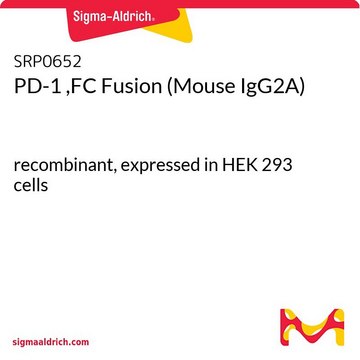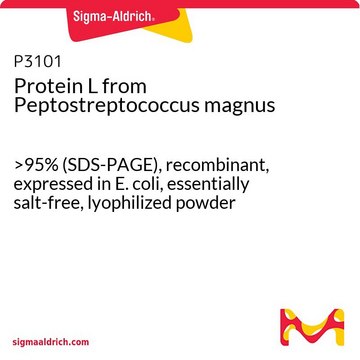08062
Protein G′ from Streptococcus sp.
recombinant, expressed in E. coli
Sinónimos:
IgG F(c)-Receptor
Iniciar sesiónpara Ver la Fijación de precios por contrato y de la organización
About This Item
Productos recomendados
biological source
bacterial (Streptococcus sp.)
Quality Level
recombinant
expressed in E. coli
form
lyophilized solid
mol wt
~30 kDa
capacity
~5 mg/mg, solid binding capacity (IgG)
storage temp.
−20°C
General description
Genetically engineered truncated protein G; retains affinity for IgG, but lacks albumin and Fab binding sites and membrane-binding regions.
Protein G, a cell wall protein, is obtained from group G streptococci. The extracellular part of this protein is made of two/three small domains or serum albumin binding (GA domains) and two/three immunoglobulin (IgG) binding domains (B domains).
Application
Protein G′ from Streptococcus sp. has been used in in vitro actin labeling assay.
Biochem/physiol Actions
Protein G can bind all the human and mouse IgG subclasses. It can bind to both the fragment crystallizable (Fc) and antigen-binding fragment (Fab) components of the antibody.
Physical form
lyophilized powder in a Tris-HCl buffer, pH 7.5
Storage Class
11 - Combustible Solids
wgk_germany
WGK 3
flash_point_f
Not applicable
flash_point_c
Not applicable
ppe
Eyeshields, Gloves, type N95 (US)
Elija entre una de las versiones más recientes:
¿Ya tiene este producto?
Encuentre la documentación para los productos que ha comprado recientemente en la Biblioteca de documentos.
Los clientes también vieron
Archana Kumari et al.
The EMBO journal, 39(14), e104006-e104006 (2020-06-23)
Cellular studies of filamentous actin (F-actin) processes commonly utilize fluorescent versions of toxins, peptides, and proteins that bind actin. While the choice of these markers has been largely based on availability and ease, there is a severe dearth of structural
Nuestro equipo de científicos tiene experiencia en todas las áreas de investigación: Ciencias de la vida, Ciencia de los materiales, Síntesis química, Cromatografía, Analítica y muchas otras.
Póngase en contacto con el Servicio técnico












